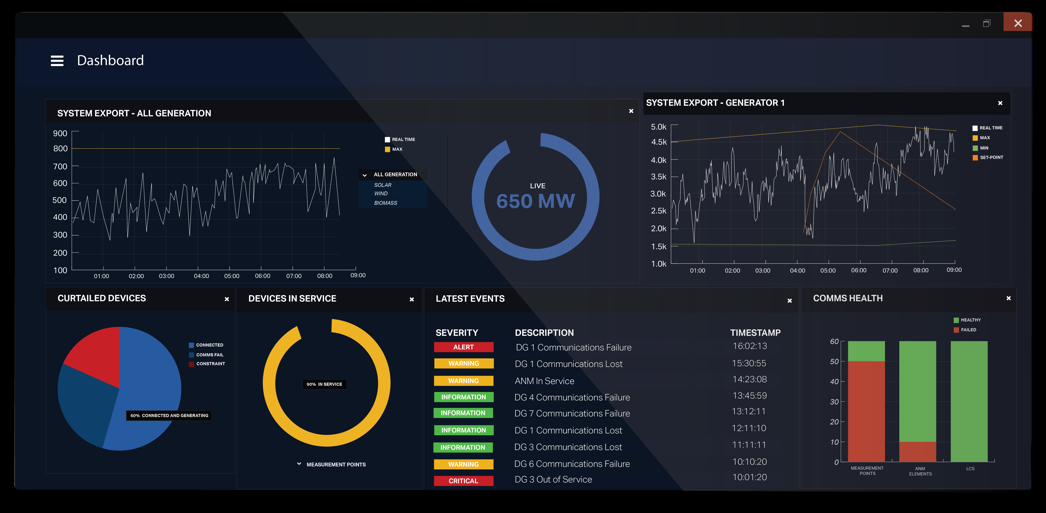ADMS vs DERMS
Discover the key differentiators between ADMS and DERMS.
As utilities strive to incorporate Distributed Energy Resources (DERs) into the grid, the need for robust management systems has become increasingly apparent. While Advanced Distribution Management Systems (ADMS) have traditionally been the go-to solutions, the growing complexity of DER integration calls for a dedicated DER Management System (DERMS) to complement an ADMS. In this blog post, we delve into the key points differentiating ADMS and DERMS, highlighting the reasons why utilities should consider implementing a separate DERMS rather than trying to integrate DERMS functionality as a module within an ADMS.
It is often thought that a natural starting point for utilities when implementing DERMS functionality is to implement a DERMS module within their existing ADMS, and many ADMS vendors create the impression that this is already achievable. This is because DERMS modules are considered incumbent, meaning they can be added without requiring additional screens in control rooms. There is also a perception that integration risks between modules might be avoided by staying with a single vendor, and successful implementation/use of ADMS functionality will carry over to DERMS use cases. However, in doing this utilities accept that the single vendor won’t provide the best solution for everything so there will need to be compromises. An ADMS is fundamentally architected around a network model for network monitoring, switching, some automated responses outage management for maintenance, rather than specifically designed to manage the many facets of DER interactions with the network. Moreover, an ADMS approach to managing DER often relies on state estimation techniques and periodic load flow simulation. Limitations from incomplete and not fully accurate network model and asynchronous datasets result in compromises to the effectiveness of these forms of grid analytics directly delivering real-time control of DER.

So, it is unrealistic for an ADMS, which is fundamentally designed for a different purpose, to offer the flexibility to deliver the breadth of calculation methods, interfaces, architectures, functions and features that is required by a DERMS, and provided by the leading DERMS vendors. A DERMS is not just a module of an ADMS, but a comprehensive ecosystem of components only some of which typically reside within the ADMS itself. DERMS offer numerous applications which address cyber security and data availability (each strengths of ADMS) but provide many new functions for DER control, reporting, market access and multiple new customer and DER technology specific use cases. Furthermore, a DERMS can enhance control room visibility of DER operation, proving valuable information for wider grid operations and enabling seamless integration with the ADMS. DERMS utilizes grid analytic engines to configure before the control loop functionality and market-adjacent use cases, some of these can lean on ADMS capabilities, but the heart of these new functions are not found in ADMS. What’s more, DERMS is specifically designed to address failure modes and control problems related to DER and their interaction with the grid, offering solutions and contingency plans for potential issues. DERMS supports both large-scale assets (typically front-of-the meter or behind-the-meter at commercial and industrial customers) using existing SCADA and utility telecoms infrastructure and small-scale resources (typically behind-the-meter at smaller commercial and residential customers) through alternative means like IoT gateways, demand response systems/aggregators, and open standard protocols direct to specific grid edge device and DER technology types.
While integrating DERMS as a module within ADMS may seem like a logical pathway, and one with a straightforward logic for ADMS vendors and some utilities, it comes with several important limitations to the specialized functionality required for effective DER management, and the progression of capabilities and use cases expected as the DER roll-out continues at pace. Utilities should consider adopting a separate DERMS solutions to overcome these challenges. Specialized DERMS vendors, like Smarter Grid Solutions, offer the native DERMS product capabilities, expertise, and integration experience necessary to architect and implement the best utility solutions. This delivers the relevant functionality for each DER management use case and acts as the glue that brings together a best in class DERMS ecosystem. By embracing a dedicated DERMS, utilities can efficiently manage their grids while maximizing the potential of distributed energy resources and leveraging the strengths of ADMS with effective integration between ADMS and DERMS.
Learn more about the Smarter Grid Solutions Suite of Products!

Leave a Comment